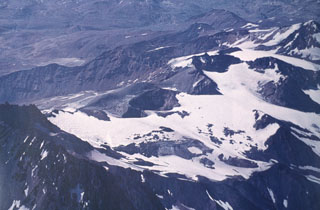Report on Planchon-Peteroa (Chile) — March 1999
Bulletin of the Global Volcanism Network, vol. 24, no. 3 (March 1999)
Managing Editor: Richard Wunderman.
Planchon-Peteroa (Chile) Unrest including ashfall and SO2 emissions in November 1998
Please cite this report as:
Global Volcanism Program, 1999. Report on Planchon-Peteroa (Chile) (Wunderman, R., ed.). Bulletin of the Global Volcanism Network, 24:3. Smithsonian Institution. https://doi.org/10.5479/si.GVP.BGVN199903-357040
Planchon-Peteroa
Chile
35.223°S, 70.568°W; summit elev. 3977 m
All times are local (unless otherwise noted)
Information from the city of Romeral's Emergency Office indicated that Planchón-Peteroa emitted noteworthy amounts of SO2 in October 1998 and showed signs of unrest in November 1998. Apparently, small phreatic eruptions produced minor explosions. Ash fell on Carrizales, ~8 km NW of the volcano, on 18 and 21 November, and fumaroles were observed from Carrizales on 24 November along with an intense SO2 odor. A local herdsman observed fine ashfall and intense fumaroles on 18 November and reported that fumes continued up to 24 November when he came down from the volcano. No seismic activity was felt. On 30 November, observers at ~3,050 m elevation on the E flank saw no fresh ash.
The volcano last erupted in February 1991 producing a 500-1,000 m column of gas and dispersing fine ash as far as 30 km ESE of the volcano.
Geological Summary. Planchón-Peteroa is an elongated complex volcano along the Chile-Argentina border with several overlapping calderas. Activity began in the Pleistocene with construction of the basaltic-andesite to dacitic Volcán Azufre, followed by formation of basaltic and basaltic-andesite Volcán Planchón, 6 km to the north. About 11,500 years ago, much of Azufre and part of Planchón collapsed, forming the massive Río Teno debris avalanche, which traveled 95 km to reach Chile's Central Valley. Subsequently, Volcán Planchón II was formed. The youngest volcano, andesitic and basaltic-andesite Volcán Peteroa, consists of scattered vents between Azufre and Planchón. Peteroa has been active into historical time and contains a small steaming crater lake. Historical eruptions from the complex have been dominantly explosive, although lava flows were erupted in 1837 and 1937.
Information Contacts: José Antonio Naranjo, Programa Riesgo Volcánico Servicio Nacional de Geología y Minería, (SERNAGEOMIN), Av. Santa María 0104, Casilla 10465, Santiago, Chile.

